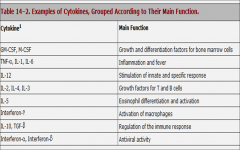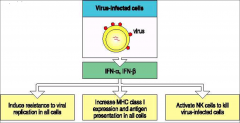![]()
![]()
![]()
Use LEFT and RIGHT arrow keys to navigate between flashcards;
Use UP and DOWN arrow keys to flip the card;
H to show hint;
A reads text to speech;
34 Cards in this Set
- Front
- Back
- 3rd side (hint)
|
Complement
One of the most important proteins of this system is the component called |
.C3.
|
|
|
|
To defend the body against foreign molecules or cells, the complement system may
stimulate = 2ct |
phagocytosis
induce lysis of microorganisms |
|
|

.
|
.
|
|
|
|
Function of the immune system is regulated by a large number of molecules, mainly =
2ct |
cytokines, which are
peptides or glycoprotein's with low molecular masses. |
|
|
|
influence both the cellular and humoral immune responses.
|
Cytokines
|
|
|
|
Cytokines
are primarily produced by cells of the immune system, mainly = 3/2 |
leukocytes
lymphocytes macrophages also be synthesized by endothelial cells fibroblasts |
|
|
|
______ & ______ are cytokines that induce the attraction of leukocytes to sites of inflammation.
|
Chemokines
Chemotaxins |
|
|
|
a family of species-specific proteins
synthesized by eukaryotic cells in response to viruses and a variety of natural and synthetic stimuli. |

Interferons
List the 3 jobs they perform from the Picture |
|
|
|
Lymphocytes are classified as =
3 ct |
B
T natural killer (NK) |
|
|
|
B
T natural killer (NK) are what class of cells |
Lymphocytes
|
|
|
|
The B and T cells are the only cells that have the ability to selectively recognize a specific =
|
epitope
|
|
|
|
B and T cells
|
have different surface proteins (markers).
their life history, surface receptors, and behavior during an immune response. |
|
|
|
all lymphocyte types originate in the
|
bone marrow
|
|
|
|
B cells can recognize
|
Soluable Antigens
|
|
|
|
T Cells can not recognize
|
Soluable Antigens
|
|
|
|
Every cell has MHC one or two ?
|
MHC 1
|
|
|
|
Not all activated B cells become =
|
plasma cells;
some remain = |
B memory lymphocytes,
|
|
|
stopped @ 34
|
.
|
|
|
|
Main Fctn CYTOKINE 1
Type = Growth & Differentiation fctr for Bone Marrow Cells |
GM-CSF
M-CSF |
|
|
|
Main Fctn CYTOKINE 1
Type = Inflammation / Fever |
TNF-a
IL-1 IL-6 |
|
|
|
Main Fctn CYTOKINE 1
Type = Stimulation of Innate Specific response |
IL-12
|
|
|
|
Main Fctn CYTOKINE 1
Type = GF for T/B Cells |
IL-2
IL-3 IL-4 |
|
|
|
Main Fctn CYTOKINE 1
Type = Eosinophil Differentiation & activation |
IL-5
|
|
|
|
Main Fctn CYTOKINE 1
Type = Activation of Macrophages |
Interferon-7
|
|
|
|
Main Fctn CYTOKINE 1
Type = Regulation of Immune Response |
TGF-beta
IL-10 |
|
|
|
Main Fctn CYTOKINE 1
Type = Antiviral Activity |
Interferon-beta
Interferon-a |
|
|
|
Type = CYTOKINE 1
Main Fctn GM-CSF M-CSF |
Growth & Differentiation fctr for Bone Marrow Cells
|
|
|
|
Type = CYTOKINE 1
Main Fctn TNF-a IL-1 IL-6 |
Inflammation / Fever
|
|
|
|
Type = CYTOKINE 1
Main Fctn IL-12 |
Stimulation of Innate Specific response
|
|
|
|
Type = CYTOKINE 1
Main Fctn IL-2 IL-3 IL-4 |
GF for T/B Cells
|
|
|
|
Type = CYTOKINE 1
Main Fctn IL-5 |
Eosinophil Differentiation & activation
|
|
|
|
Type = CYTOKINE 1
Main Fctn Interferon-7 |
Activation of Macrophages
|
|
|
|
Type = CYTOKINE 1
Main Fctn IL-10 TGF-beta |
Regulation of Immune Response
|
|
|
|
Type = CYTOKINE 1
Main Fctn Interferon-a Interferon-beta |
Antiviral Activity
|
|

